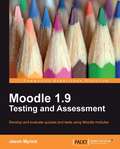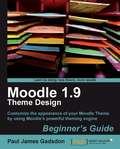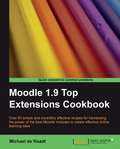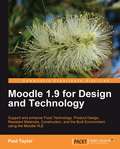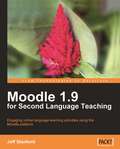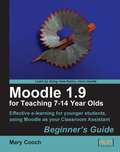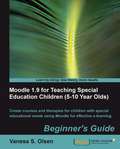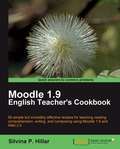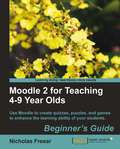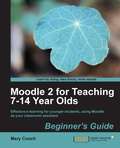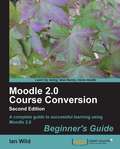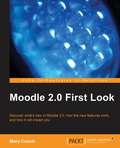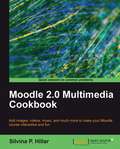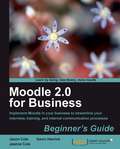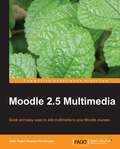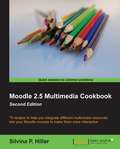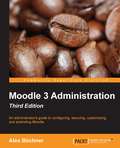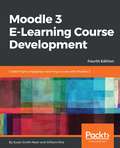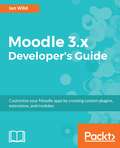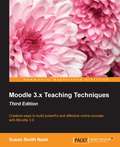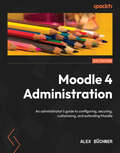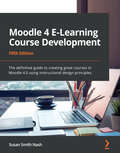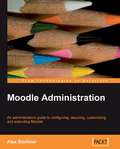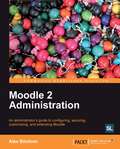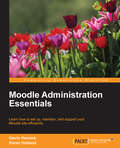- Table View
- List View
Moodle 1.9 Testing and Assessment
by Jason MyrickThis book is an illustrative how-to guide with many screenshots and examples that helps you to create simple to complex tests and assess them using Moodle. It covers effective usage of tools available in Moodle and offers some Moodle options that you may not have tried yet. It will guide you from the basic philosophy of online testing to creating skill-based assessments in Moodle.If you are a tutor or Moodle Administrator who is responsible for developing and evaluating an online test using Moodle, then this book is for you.This book assumes that you have already successfully installed and set up a Moodle site for teaching.
Moodle 1.9 Theme Design: Beginner's Guide
by Paul James GadsdonThis is a Beginner's Guide, with plenty of worked examples, step-by-step visual guides, and explanations. If you are a Moodle administrator, ICT technical personnel, designer or a teacher and wish to enhance your Moodle site to make it visually attractive, then this book is for you. You should be familiar with the basics of Moodle operation, and some familiarity with web design techniques, such as HTML and CSS, will be helpful.
Moodle 1.9 Top Extensions Cookbook
by Michael De RaadtThe disorganised array of modules available for Moodle are brought together in ways you can relate to. Reviews include details that will help you decide if a module is worth testing. There are illustrated, step-by-step guides to installing and configuring modules.If you are involved in teaching using Moodle, be it at relatively small institutions running their own Moodle instance, or at large institutions where Moodle is used and administered, or you are an administrator of a Moodle instance who is looking for modules that will be useful to teachers and students at their institution, this book is meant for you.Get students organised and help them manage their time
Moodle 1.9 for Design and Technology
by Paul TaylorThis book has real-world samples of how to solve problems related to Design and Technology and offers tips on how to enhance the use of Moodle to get the most out of the subject. Worked examples will act as a base from which to build complex and exciting courses for students in all age ranges and abilities. If you are a Design & Technology teacher, teaching assistant, head of department, SMT, or IT technician in school and would like to use Moodle to design, create, or administer a VLE for Design and Technology, this book is for you. You need to know the basics of Moodle for teaching and learning and should have some experience with Design and Technology.
Moodle 1.9 for Second Language Teaching
by Jeff StanfordThe author's experience as a teacher enables him to combine a simple, descriptive how-to approach with enthusiastic insights into the rich potential of Moodle for creating engaging, useful language learning activities. The book is based on Moodle 1.9 and gives clear instructions with lots of screenshots. There are dozens of examples of activities that you can use to create your own online activities. This book is written for teachers, trainers, and course planners with little or no experience of Moodle who want to create their own language learning activities.
Moodle 1.9 for Teaching 7-14 Year Olds: Beginner's Guide
by Mary CoochThis book is part of Packt's Beginner's Guide series. Written in a friendly tone, the book starts at the very beginning with a blank Moodle page and you are taken step by step through the most useful features of Moodle, helped with many illustrative screenshots. The chapters gradually build up your skills and by the end of the book you will be confident enough to design a fully functional, interactive course for 7-14 year olds. This book is for regular, non-technical teachers of pre-teen or early teenage children. It assumes no prior knowledge of Moodle and no particular expertise on the Web. Classroom assistants may also find this book a very useful resource.
Moodle 1.9 for Teaching Special Education Children (5-10): Beginner's Guide
by Vanesa S. OlsenWritten with a step-by-step but friendly and engaging approach, this Packt Beginner's Guide is designed to be placed alongside the computer as your guide and mentor. Step-by-step tutorials are boosted by explanations of the reasoning behind what you are doing. You will quickly pick up the necessary skills, tips, and tricks for creating practical exercises using Moodle 1.9 with practical examples and see how the child with special education needs progresses. If you are an SEN teacher or SEN therapist with minimal knowledge of Moodle who is willing to exploit Web 2.0 possibilities using Moodle 1.9 as the background platform, this book is for you.
Moodle 1.9: The English Teacher's Cookbook
by Silvina P. HillarThis book follows a cookbook style, which will help you achieve outstanding results using ready-to-use recipes for reading comprehension, writing, and composition holding hands with Moodle 1.9 in the Web 2.0 Era. Each recipe is unique; some deal with similar teaching techniques, but they show how to develop the same technique using different software, situations, or topics. Images, videos, poems, songs, artists, classic stories, cartoons, superheroes, painting, the environment, and comics are inserted into the Moodle course, in order to be used as either prewriting or writing activities. If you are an English teacher who wants to discover practical, funny, and engaging activities to insert in your course, this is a perfectly designed book for you. It will help you to use different techniques in the teaching of reading comprehension, writing, and composition using a great variety of resources from the free and open source software available in the Web and interesting websites as well as social networks. You need basic experience with Moodle 1.9 or 1.9.5, as well as installation and configuration procedures.
Moodle 2 for Teaching 4-9 Year Olds Beginner's Guide
by Nicholas FreearPart of Packt's Beginner's Guide series, this book will steadily guide the reader through exercises using practical examples that are easy to build, which are illustrated with screenshots. The activities become steadily more sophisticated and include combining the content from one module with another. This book is aimed at teachers of children aged 4 to 9 who wish to integrate the Moodle open source virtual learning environment into their teaching. It assumes a basic knowledge of the Web but no prior knowledge of Moodle, although it is expected that you will either have Moodle already set up in your school, or a friendly IT technician who can do it for you.
Moodle 2 for Teaching 7-14 Year Olds Beginner's Guide
by Mary CoochThis book is part of Packt's Beginner's Guide series. Written in a friendly tone, the book starts at the very beginning with a blank Moodle page and you are taken step by step through the most useful features of Moodle, helped with many illustrative screenshots. This book is for regular, non-technical teachers of pre-teen or early teenage children. It assumes no prior knowledge of Moodle and no particular expertise on the web. Classroom assistants may also find this book a very useful resource. We will assume that you have an installation of Moodle managed by somebody else, so you are responsible only for creating and delivering course content.
Moodle 2.0 Course Conversion, Second Edition
by Ian WildWith clear instructions and plenty of screenshots, this book provides all the support and guidance you will need as you begin to convert your teaching to Moodle. Step-by-step tutorials use real-world examples to show you how to convert to Moodle in the most efficient and effective ways possible. Moodle Course Conversion carefully illustrates how Moodle can be used to teach content and ideas and clearly demonstrates the advantages of doing so. This book is for teachers, tutors, and lecturers who already have a large body of teaching material and want to use Moodle to enhance their course, rather than developing brand new ones. You won't need experience with Moodle, but will need teacher-access to a ready-installed Moodle site. Teachers with some experience of Moodle, who want to focus on incorporating existing course materials will also find this book very useful
Moodle 2.0 First Look
by Mary CoochThe book looks at the main functional areas of Moodle that have significant new features, explains the new features and how to use them. It draws attention to significant differences from how things used to behave, and gives the reader an idea of the kind of consequences these changes will bring to them. If you are an existing Moodle user, tutor, or administrator, then this book is for you. You are expected to be familiar with the operation of Moodle.
Moodle 2.0 Multimedia Cookbook
by Silvina P. HillarPart of Packt's Cookbook series, each chapter focuses on a different multimedia effect. If you don't have the time to work your way through a long tutorial, then this is the book for you. The step-by-step recipes are independent from each other so you can dip in and out of the book to add great effects to your course as and when you need them. This cookbook is designed for teachers who want to learn how to insert different multimedia assets into their Moodle courses. It is expected that you will have basic knowledge of Moodle 1.9 or 2.0 and have Moodle installed and ready to be worked on. Teachers of different subjects can adapt the recipes to best suit their specific subject.
Moodle 2.0 for Business Beginner's Guide
by Jeanne Cole Gavin HenrickPart of Packt's Beginner's Guide series, each chapter looks at a different aspect of using Moodle in a business environment, and steadily guides the reader through setting Moodle up in their own business with the help of practical examples, accompanied by lots of screenshots. Each chapter also includes case studies from well-known companies that have already implemented Moodle. If you are responsible for training, recruitment, or maintaining any guidelines within your company, then this book is for you. No previous experience with Moodle is necessary as the examples are easy to follow
Moodle 2.5 Multimedia
by Joao Pedro FernandesA tutorial-based guide where readers can work through practical examples that clearly describe how to create multimedia applications using Moodle and integrate existing multimedia resources into Moodle courses.If you are a teacher or trainer who runs online courses and has a basic understanding of Moodle, this book will be ideal for you. It is not necessary to have an advanced technical background to create multimedia elements as the tasks will be simple, not time consuming, and will be practical for everyday use.
Moodle 2.5 Multimedia Cookbook - Second Edition
by Silvina P. HilarWith practical examples presented in the style of recipes, this book is designed for you to be able to dip in and out as you need, only using the multimedia options that you want at the time.This cookbook is designed specifically for teachers who want to begin creating interactive and engaging Moodle courses by utilizing the multimedia capabilities of Moodle.
Moodle 2.7 LTS Administration - Third Edition
by Alex BuchnerThe book takes a problem-solution approach to fall in line with your day-to-day operations. This is a one-stop reference for any task you will ever come across when administering a Moodle site of any shape and size. If you are a technician, systems administrator, or part of academic staff, this is the book for you. This book is ideal for anyone who has to administer a Moodle system. Whether you are dealing with a small-scale local Moodle system or a large-scale multi-site Virtual Learning Environment, this book will assist you with any administrative task. Some basic Moodle knowledge is helpful, but not essential.
Moodle 3 E-Learning Course Development: Create highly engaging and interactive e-learning courses with Moodle 3, 4th Edition
by Susan Smith NashA complete guide on course development and delivery using Moodle 3.xKey FeaturesGet the best out of the latest Moodle 3 framework to ensure successful learningCreate 3rd party plugins and widgets and secure your course efficientlyCreate your first Moodle VR app using the Moodle VR toolsetBook DescriptionMoodle is a learning platform or Course Management System (CMS) that is easy toinstall and use, but the real challenge is in developing a learning process that leverages its power and maps the learning objectives to content and assessments for an integrated and effective course. Moodle 3 E-Learning Course Development guides you through meeting that challenge in a practical way.This latest edition will show you how to add static learning material, assessments, and social features such as forum-based instructional strategy, a chat module, and forums to your courses so that students reach their learning potential. Whether you want tosupport traditional class teaching or lecturing, or provide complete online and distancee-learning courses, this book will prove to be a powerful resource throughoutyour use of Moodle.You’ll learn how to create and integrate third-party plugins and widgets in your Moodle app, implement site permissions and user accounts, and ensure the security of content and test papers. Further on, you’ll implement PHP scripts that will help you create customized UIs for your app. You’ll also understand how to create your first Moodle VR e-learning app using the latest VR learning experience that Moodle 3 has to offer.By the end of this book, you will have explored the decisions, design considerations, andthought processes that go into developing a successful course.What you will learnKnow what Moodle does and how it supports your teaching strategiesInstall Moodle on your computer and navigate your way around itUnderstand all of Moodle's learning featuresMonitor how learners interact with your site using site statisticsAdd multimedia content to your siteAllow students to enroll themselves or invite other students to join a courseWho this book is forThis book is for anyone who wants to get the best out of Moodle. As a beginner, this is a thorough guide for you to understand how the software works, with great ideas for getting off to a good start with your first course. Some experience of working with e-learning systems will be beneficial. Experienced Moodle users will find powerful insights into developing successful and educational courses.
Moodle 3.x Developer's Guide
by Ian WildEffortlessly ensure your application's code quality from day 1 About This Book • Customize your Moodle 3.x app. • Leverage the new features of Moodle 3.x by diving deep into the Moodle development eco-system. • Cater to heavy user traffic, customize learning requirements and create custom third party plugins. Who This Book Is For This book is for Moodle developers who are familiar with the basic Moodle functionality and have an understanding of the types of scenarios in which the Moodle platform can be usefully employed. You must have medium-level PHP programming knowledge. You should be familiar with HTML and XML protocols. You do not need to have prior knowledge of Moodle-specific terminology What You Will Learn • Work with the different types of custom modules that can be written for Moodle 3.x • Understand how to author custom modules so they conform to the agreed Moodle 3.x development guidelines • Get familiar with the Moodle 3.x architecture—its internal and external APIs • Customize Moodle 3.x so it can integrate seamlessly with third-party applications of any kind • Build a new course format to specify the layout of a course • Implement third-party graphics libraries in your plugins • Build plugins that can be themed easily • Provide custom APIs that will provide the means to automate Moodle 3 in real time In Detail The new and revamped Moodle is the top choice for developers to create cutting edge e-learning apps that cater to different user's segments and are visually appealing as well. This book explains how the Moodle 3.x platform provides a framework that allows developers to create a customized e-learning solution. It begins with an exploration of the different types of plugin.. We then continue with an investigation of creating new courses. You will create a custom plugin that pulls in resources from a third-party repository. Then you'll learn how users can be assigned to courses and granted the necessary permissions. Furthermore, you will develop a custom user home. At the end of the book, we'll discuss the Web Services API to fully automate Moodle 3.x in real time. Style and approach This book takes a step-by-step practical approach with every step explained in great detail using practical examples. You will create custom plugins from scratch with the examples shown and create new modules as well as extensions with the examples presented.
Moodle 3.x Teaching Techniques - Third Edition
by Susan Smith NashCreative ways to build powerful and effective online courses with Moodle 3.0 About This Book * Unleash your teaching talents and develop exciting, dynamic courses * Put together effective online courses that motivate students from all backgrounds, generations, and learning styles * Find powerful insights into developing more successful and educational courses Who This Book Is For If you want to unleash your teaching talents and develop exciting, dynamic courses that really get students moving forward, then this book is for you. Experienced Moodlers who want to upgrade to Moodle 3.0 will find powerful insights into developing more successful and educational courses. What You Will Learn * Create a dynamic learning environment using different techniques * Motivate your students to collaborate and demonstrate what they are learning and to create projects together * Develop materials you can re-use in your future courses * Create online workshops and galleries for your students to make presentations about what they have learned * Engage your students in team work that helps them connect course content with their experiences and prior learning * Develop high-quality courses that will last to create a personal inventory you can use and re-use In Detail Moodle, the world's most popular, free open-source Learning Management System (LMS) has released several new features and enhancements in its latest 3.0 release. More and more colleges, universities, and training providers are using Moodle, which has helped revolutionize e-learning with its flexible, reusable platform and components. This book brings together step-by-step, easy-to-follow instructions to leverage the full power of Moodle 3 to build highly interactive and engaging courses that run on a wide range of platforms including mobile and cloud. Beginning with developing an effective online course, you will write learning outcomes that align with Bloom's taxonomy and list the kinds of instructional materials that will work given one's goal. You will gradually move on to setting up different types of forums for discussions and incorporating multi-media from cloud-base sources. You will then focus on developing effective timed tests, self-scoring quizzes while organizing the content, building different lessons, and incorporating assessments. Lastly, you will dive into more advanced topics such as creating interactive templates for a full course by focussing on creating each element and create workshops and portfolios which encourage engagement and collaboration Style and approach With clear, step-by-step instructions, this book helps you develop good, solid, dynamic courses that will last by making sure that your instructional design is robust, and that they are built around satisfying learning objectives and course outcomes. Packed with plenty of screenshots and practical examples, you will get solid understanding of developing courses that are a success in the real world.
Moodle 4 Administration: An administrator's guide to configuring, securing, customizing, and extending Moodle, 4th Edition
by Alex BuchnerA practical guide filled with over 120 infographics to help you administer Moodle for large organizations and small enterprises, updated to Moodle 4 and packed with real-world examples addressing today's LMS needsKey FeaturesLearn how to plan, install, customize, and optimize Moodle and Moodle WorkplaceDeliver a cutting-edge learning experience in a secure and customizable environment while optimizing the Moodle environmentDiscover solutions to common problems while administering Moodle using a wide range of real-world examplesBook DescriptionThis updated fourth edition of the classic Moodle Administration guide has been written from the ground up and covers all the new Moodle features in great breadth and depth. The topics have also been augmented with professional diagrams, illustrations, and checklists.The book starts by covering basic tasks such as how to set up and configure Moodle and perform day-to-day administration activities. You'll then progress to more advanced topics that show you how to customize and extend Moodle, manage authentication and enrolments, and work with roles and capabilities. Next, you'll learn how to configure pedagogical and technical Moodle plugins and ensure your LMS complies with data protection regulations. Then, you will learn how to tighten Moodle's security, improve its performance, and configure backup and restore procedures. Finally, you'll gain insights on how to compile custom reports, configure learning analytics, enable mobile learning, integrate Moodle via web services, and support different types of multi-tenancy.By the end of this book, you'll be able to set up an efficient, fully fledged, and secure Moodle system.What you will learnGet expert techniques to handle courses, categories, and enrolments in MoodleManage users, cohorts, roles, and authentication in a professional mannerConfigure and manage core and third-party plugins and integrations like a proExplore different levels of technical and educational configurationEnhance Moodle's look and feel to create engaging user experiences and ensure compliance with your corporate brandingGain insights by creating powerful custom reports and learning analyticsEnsure your Moodle or Moodle Workplace complies with the latest GDPR regulationsSupport different learning settings, including home-office based learning, mobile learning, and multi-tenancyWho this book is forIf you're new to Moodle or an experienced administrator, this book is for you. It's also ideal for anyone who has to administer a Moodle system. Whether you're dealing with a small-scale local Moodle site or a large-scale multi-site learning management system, this book will assist you with any administrative task you may encounter on your journey. Basic Moodle or Moodle Workplace knowledge will be helpful, but not essential.
Moodle 4 E-Learning Course Development: The definitive guide to creating great courses in Moodle 4.0 using instructional design principles, 5th Edition
by Susan Smith Nash William RiceLeverage Moodle 4.0's improved UX features and new tools to create effective courses in today's competitive world of online learning, including blended live and on-demand deliveryKey FeaturesDesign courses that are easy to navigate and have easy-to-use productivity toolsEffectively incorporate text, audio, video, and graphics that are ADA compliant and meet the needs of all kinds of learnersBuild the best assessment tools for your learning objectivesBook DescriptionMoodle 4.0 maintains its flexible, powerful, and easy-to-use platform while adding impressive new features to enhance the user experience for student success.This updated edition addresses the opportunities that come with a major update in Moodle 4.0. You'll learn how to determine the best way to use the Moodle platform's new features and configure your courses to align with your overall goals, vision, and even accreditation review needs. You'll discover how to plan an effective course with the best mix of resources and engaging assessments that really show what the learner has accomplished, and also keep them engaged and interested. This book will show you how to ensure that your students enjoy their collaborations and truly learn from each other. You'll get a handle on generating reports and monitoring exactly how the courses are going and what to do to get them back on track. While doing this, you can use Moodle 4.0's new navigation features to help keep students from getting “lost.” Finally, you'll be able to incorporate functionality boosters and accommodate the changing needs and goals of our evolving world.By the end of this Moodle book, you'll be able to build and deploy your educational program to align with learning objectives and include an entire array of course content.What you will learnBuild courses that emphasize the achievement of learning objectivesWrite a variety of effective quizzes that can be taken online and offlineMake the most of the navigation and user experience improvements made to Moodle 4.0Build courses that reflect current interactive teaching practices, including hybrid learning with web conferencingOptimize all kinds of content – text, graphics, audio, video, and recorded webcastsEncourage student engagement and collaborationIncorporate functionality builders for more responsive and adaptive learningWho this book is forThis book is for novice as well as experienced course developers who want to incorporate Moodle 4.0's powerful features and make life easier for students, instructors, and administrators. The powerful and flexible Moodle platform will also help with accreditation and for deploying across devices to people in diverse situations.
Moodle Administration
by Alex BuchnerWritten in a clear, straightforward way with lots of screenshots and direct instructions this book will equip you with all the tools you need to set up, optimize, extend, and maintain a Moodle system. A problem-solution approach has been taken when possible to bring the content more in line with your day-to-day operations. This book is written for technicians, systems administrators, as well as academic staffâ "basically anyone who has to administer a Moodle system. Whether you are dealing with a small-scale local Moodle system or a large-scale multi-site Virtual Learning Environment, this book will assist you with any administrative tasks. Some basic Moodle knowledge is helpful, but not essential.
Moodle Administration
by Alex BuchnerWritten in a clear, straightforward way with lots of screenshots and direct instructions this book will equip you with all the tools you need to set up, optimize, extend, and maintain a Moodle system. A problem-solution approach has been taken when possible to bring the content more in line with your day-to-day operations. This book is written for technicians, systems administrators, as well as academic staffâ "basically anyone who has to administer a Moodle system. Whether you are dealing with a small-scale local Moodle system or a large-scale multi-site Virtual Learning Environment, this book will assist you with any administrative tasks. Some basic Moodle knowledge is helpful, but not essential.
Moodle Administration Essentials
by Gavin Henrick Karen HollandIf you are an experienced system administrator and know how to manage servers and set up web environments but now want to explore Moodle, this book is perfect for you. You'll get to grips with the basics and learn to manage Moodle quickly, focusing on essential tasks. Having prior knowledge of virtual learning environments would be beneficial, but is not mandatory to make the most of this book.
